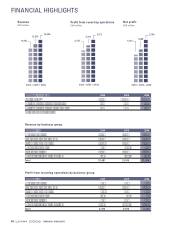Louis Vuitton 2006 Annual Report Download - page 12
Download and view the complete annual report
Please find page 12 of the 2006 Louis Vuitton annual report below. You can navigate through the pages in the report by either clicking on the pages listed below, or by using the keyword search tool below to find specific information within the annual report.In agreement with the Chairman and Chief
Executive Officer, the Board of Directors has
appointed a Managing Director who has the
same powers as the Chief Executive Officer.
PERFORMANCE AUDIT COMMITTEE
The Performance Audit Committee is prima-
rily responsible for ensuring the compliance of
the accounting principles followed by the
Company and the Group and for reviewing the
corporate and consolidated financial statements
before they are submitted to the Board of Direc-
tors.
It has currently 3 directors, 2 of whom are inde-
pendent. Its members and Chairman are
appointed by the Board of Directors.
The Audit Performance Committee met three
times in 2006. All the meetings were attended
by all members, as well as by the Auditors, the
Chief Operating Officer, the Chief Financial
Officer, the Management Control Director, the
Internal Audit Director, the Accounting Direc-
tor, the General Counsel and, depending on the
issues discussed, the Director of Financing, and
the Treasurer.
In addition to reviewing the corporate and
consolidated financial statements, the work of
the Committee focused primarily on compliance
with IFRS, the currency hedging policy, evalua-
tion of the Groups brands and goodwill, and
transactions connected with coverage of option
plans and the formation of the Louis Vuitton
pour la Création foundation.
NOMINATING
AND COMPENSATION COMMITTEE
The responsibilities of the Nominating and
Compensation Committee are listed below:
"recommendations on the distribution of
Directors fees paid by the Company, as well as
compensation, in-kind benefits and stock
The Board of Directors has adopted a Charter
that spells out the membership, mandates,
operations and responsibilities of the Board of
Directors.
The Board of Directors has two Committees,
the membership, role and mandates of which
are defined by internal procedural rules.
The Board of Directors Charter and the rules
of the Committees are provided to every candi-
date for the position of director, and to the
permanent representative of any legal entity,
before he assumes his duties.
BOARD OF DIRECTORS
The Board of Directors is made up of 18
members, 6 of whom are independent and free
of any interests with respect to the Company.
Members of the Board of Directors must perso-
nally own at least 500 shares of LVMH.
The Board of Directors met four times in 2006,
with an average attendance rate of 84%. The
Board approved the annual and interim finan-
cial statements and reviewed the Groups major
strategic guidelines, budget, the implementa-
tion of a stock subscription option plan and
the allotment of bonus shares, authorization
for third party guarantees, as well as various
agreements with affiliated companies.
LVMH paid a total of 1,110,000 euros in direc-
tors fees to the members of its Board of Direc-
tors. These fees were distributed among the
directors and advisors in accordance with a
distribution key defined by the Board of Direc-
tors that takes into account the duties perfor-
med on the Board and in the Committees.
EXECUTIVE MANAGEMENT
The Chairman of the Board of Directors also
serves as Chief Executive Officer of the
company. The Chief Executive Officers powers
are not limited in any way.
options granted to the Chairman of the Board
of Directors, the Chief Executive Officer and
the Deputy Managing Director(s) of the
Company,
"opinions on candidates for the positions of
Director, Advisor to the Board or membership
on the Executive Committee of the Group or
the general management of its principal subsi-
diaries, on the compensation and in-kind bene-
fits granted to the Directors and Advisors of
the Company by the Company or its subsidia-
ries, and on fixed or variable, immediate or
deferred compensation and incentive plans for
senior executives of the Group.
The Committee has 3 members, 2 of whom are
independent. Its members and Chairman are
appointed by the Board of Directors.
The Committee met twice in 2006 with all its
members in attendance. It issued recommen-
dations on compensation and the awarding of
stock options to senior executives, and issued an
opinion on the compensation awarded to some
Directors by the Company or its subsidiaries.
ADVISORY BOARD
The Shareholders Meeting may, on the recom-
mendation of the Board of Directors, appoint a
maximum of nine advisors.
The advisors are drawn from the shareholders
based on individual merit, and form an Advi-
sory Board.
They are appointed for a three-year term that
ends immediately after the Shareholders
Meeting called to approve the financial state-
ments for the previous fiscal year, which is held
during the year in which an Advisors term
expires.
Advisors are invited to attend Board of Direc-
tors meetings and participate in the delibera-
tions in an advisory capacity; their absence does
not affect the validity of these proceedings.
The Advisory Board currently has one member.
COMPENSATION POLICY
Part of the compensation paid to members of
the Executive Committee and key operations
personnel is based on the generation of cash,
operating profit, and the return on capital
employed for the business groups and compa-
nies headed by the respective executives, as well
as on their individual performance. The variable
portion generally represents between one-third
and one-half of their compensation.
CORPORATE GOVERNANCE
The objectives of the Board of Directors, the strategic
body of LVMH, are to ensure the sustainable
development of the value of the company, to adopt
the major strategies that guide its management,
to verify the fair and accurate presentation
of information about the company, and to protect
its corporate assets. As part of its mission, the Board
of Directors supports the priority objective of LVMH
management, which is, as it always has been, to ensure
the continuous growth of the Group and a steady
increase in value for its shareholders.
10
LVM H 2 0 0 6
CORPORATE GOVERNANCE
























